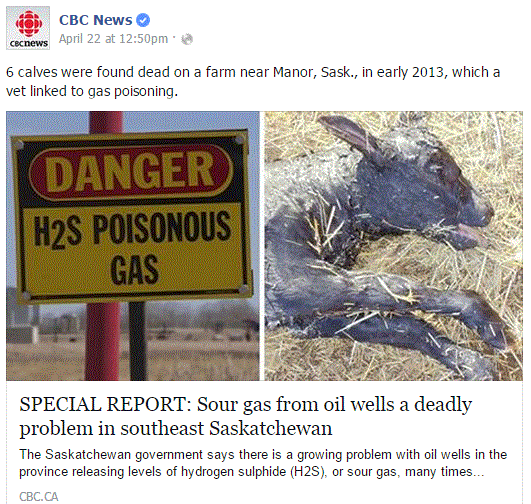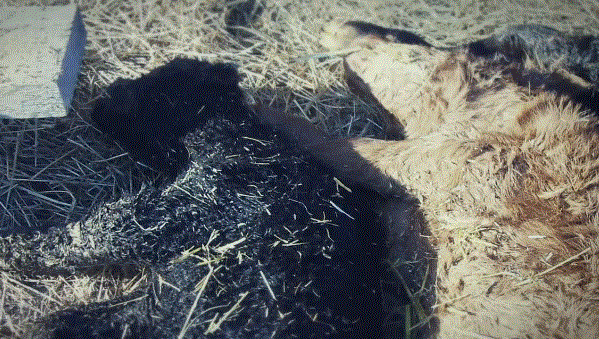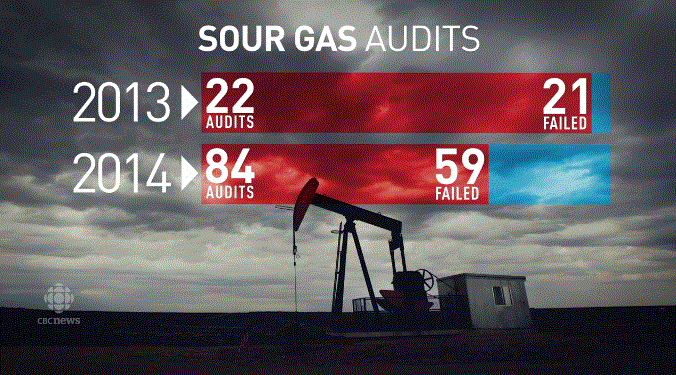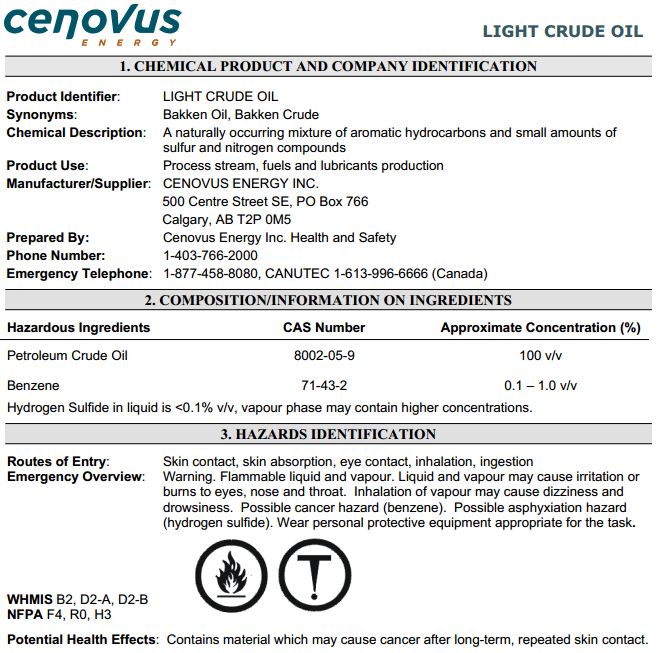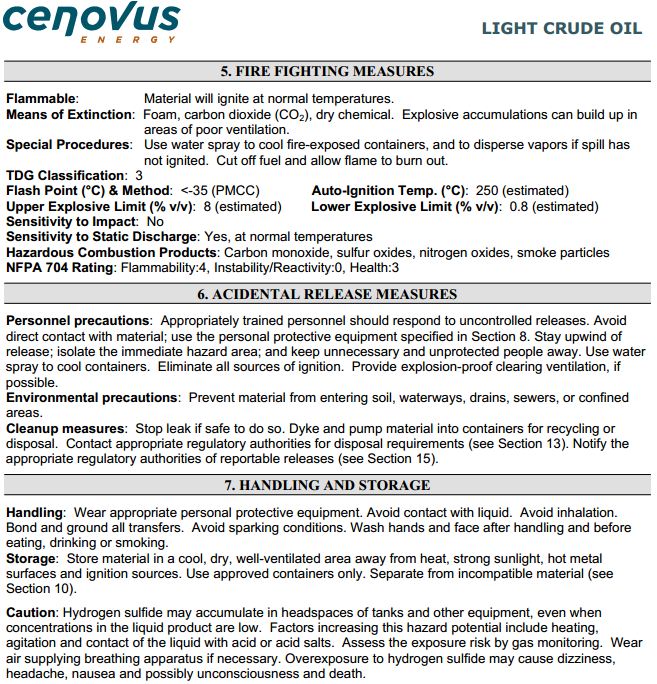Why did it take over two years for this to be made public?
SPECIAL REPORT: Rapidly growing oil industry causing health concerns in southeast Sask, ‘They are just pillaging,’ says Oxbow resident by CBC News with files from Roxanna Woloshyn, April 22, 2015
It’s not just people living near wells who are concerned about the growing sour gas problem in southeast Saskatchewan.
CBC’s iTeam has reported that a growing number of wells are producing and leaking deadly levels of the toxic substance, which is also known as hydrogen sulfide (H2S).
Sour gas from oil wells a deadly problem in southeast Saskatchewan
The provincial government has confirmed that in one case, several calves appear to have been killed by the toxic gas. In addition, Occupational Health and Safety (OHS) is investigating the death of a Wawota man who was poisoned by sour gas almost a year ago.
Lisa Drummond, who’s an office manager in the town of Oxbow, Sask., said the toxic fumes are starting to affect her daily life. Oxbow is about 250 kilometres southeast of Regina.
She’s still having headaches after being overwhelmed by sour gas while driving near a school in the area in January.
“It was so strong by the time I got to the gas station, I flung my door open and I almost vomited in the parking lot,” Drummond said. “That’s how strong it was.”
She said she was nauseous all day and “I have not felt 100 per cent since this happened in late January.”
Drummond said she moved to Oxbow seven years ago for the peaceful rural lifestyle, but she said since that time the oil industry has expanded in the area at an astonishing rate.
“This was our valley before they came in here. Like they are just pillaging,” Drummond said.
She says the area is now overrun with signs of the industry like pump jacks and flaring.
“It is not a pretty sight anymore to drive by and see all those things out there.”
Professor studies the effects of booming industry
An economic geographer from the University of Regina said over the past few years there has been a lot of very public celebration about the benefits of the oil industry, but not much talk about the costs.
Emily Eaton is researching the effects of the economic boom in southeast Saskatchewan and she said she’s found that some people don’t feel they can speak freely.
‘They are suffering from the impacts of development, but they are to a certain extent cautious about speaking about those impacts because they think it might endanger, for example, their neighbours or their child’s job,” Eaton said.
But she said, what residents and people in the industry have told her has raised serious questions about the sustainability of the growth.
“I think that the pace of development is really outrageous right now and we don’t have the resources or the staff to keep up with what’s happening,” Eaton said.
Eaton notes that there are just a handful of inspectors, charged with enforcing the rules on 80,000 wells in the province.
According to the Ministry of Economy, there are 16 inspectors in Saskatchewan. They’re responsible for inspecting 10,000 wells in the province this year, or 625 wells each.
In addition, they’re required to inspect new drilling projects and pipelines and review any spills.
The assistant deputy minister for the petroleum and natural gas division of the ministry of economy agrees that because of the booming economy it’s been difficult for industry and government to keep up. But he said this year he’s asked his inspectors to focus on the wells that are most likely to be sour.
“There’s been sites that have not received the attention they should,” Ed Dancsok said. “So our stepped-up enforcement actions are starting to correct that.”
And Dancsok said, he’s turned to Alberta, which has had serious problems with sour gas in the past.
“We are already engaged with Alberta Energy, the regulator, to leverage some of their learnings on their four year strategy that they’ve just completed and using that to guide us to the future.” [Refer below to deregulation Directive 60 below, and W5 News coverage on the AER when it was the ERCB]
Eaton said she’s talked with oil companies that have moved to Saskatchewan from Alberta who’ve been struck by the lack of oversight in this province. “Because staffing in the petroleum development branch field offices is so low, they are not under the same kind of scrutiny that they are in Alberta.” Eaton said that fact may lead some companies to bend the rules. [That doesn’t happen the oil and gas industry operates everywhere?]
“There are some good rules that exist, but the culture isn’t to take those necessarily as seriously as companies should, because they know they can take shortcuts because they are not being closely monitored.” [Like everywhere the oil and gas industry operates]
The vice president of western Canadian operations for the Canadian Association of Petroleum Producers agreed with Eaton that Saskatchewan’s rules are good. And Brad Herald also agreed that the province lags behind Alberta when it comes to enforcement. [CAPP Comedy Hour?] But he argued that’s not necessarily good for his members. He said industry and government both want compliance with the rules. “Our members want a level playing field. They don’t want to see anybody skirting those rules either purposefully or unintentionally.” He said if companies are allowed to flout the rules, that gives them a competitive advantage over firms that do the right thing.
Veterinarian turned H2S watchdog
Phil Murray told CBC’s iTeam that even though he’s a veterinarian and rancher by trade, he’s had to take on a watchdog role, when it comes to industry emissions. “Our aim is not to be obstructive or abusive. Our aim is to have the problem fixed so we’re not putting up with the possible effects of H2S on our livestock.”
Murray said he has often complained to the industry about odour. He said sometimes, when there’s no response, he’s had to elevate his concerns all the way to the minister’s office.
He said it’s a delicate situation, because he does business with oil companies, while at the same time complaining about toxic fumes. “Yes we enjoy the oil patch income. It often makes life a lot more comfortable, especially when you are nearing retirement,” Murray said.
“But we do not want to have health risk and we do not want to have health risk to our livestock.”
Herald agrees that the relationship between industry and communities can be difficult.
He said on the upside, a booming industry brings in lots of people and jobs. “It’s been a boom for the province,” Herald pointed out.
“But certainly there’s some drawbacks if you’re in the local area with that type of increase in industry activity.” [Emphasis added]
Alberta Energy Regulator should be Ashamed … Having read these documents in their entirety, I am not fooled by the shallow affirming statements of regulatory executives but appalled by their audacity to advertise these changes as progressively better.
Of greatest concern is that off-lease odours are now permitted from energy sites. The previous document was clear; no off-lease odours were allowed.
Reasonably so, NO contamination should be leaving these sites. To point out the obvious, these are not odours; cooking fish in the house causes odours. Flaring, incineration and venting create emissions containing numerous hazardous and toxic chemicals. Many of these substances are definitively known to impact health and at levels below olfactory detection.
… Sour gas air quality dispersion guidelines have also changed exponentially.
The previous regulations required analysis on sour gas wells over one per cent; that value is now five per cent. Five per cent equates to 50,000 ppm and H2S is fatal at 1,000 ppm.
Byproducts of burning acid gas such as sulphur dioxide and carbon disulphide are potent respiratory and neurological toxins. To increase the dispersion modelling to such a degree demonstrates total disregard for the health and safety of communities where industry operates.
It is impossible to reconcile how these changes are an improvement, unless you are an oil company after shale gas.
Sour gas issue in southeast Sask becomes political, Minister of Economy questioned in the legislature following CBC iTeam story on deadly sour gas emissions by CBC News, April 22, 2015
Saskatchewan’s Minister of the Economy, Bill Boyd, was quizzed Wednesday about how officials are monitoring emissions of sour gas at well sites across the province following a CBC iTeam report about serious concerns associated with the sites.
Boyd said the province is seeing more sour gas than ever before and that is why he is ramping up the number of inspections at well sites.
“We are certainly concerned about the issue, that’s why we do the number of inspections we do do here,” said Boyd.
On Tuesday, CBC’s iTeam reported that 43 facilities the ministry tested in southeast Saskatchewan were emitting hydrogen sulphide (H2S) at levels 30 times greater than the lethal levels.
The province has received numerous health complaints from the public, including a report of dead cows linked to H2S emissions.
During question period Wednesday, NDP rural affairs critic Cathy Sproule asked the minister why the government did not disclose the information to the public ahead of the media report.
Boyd didn’t say why the province didn’t reveal the emissions problem when it first realized the scale of the problem. However, he did say it is an issue his ministry is taking seriously. “We are certainly prepared to ramp up even further our inspections, if we feel it necessary,” Boyd said.
He acknowledged there were not enough inspections being done in the past.
The province has 16 full time inspectors responsible for inspecting the wells. It has committed to assigning four or five more employees to enforcement. According to Boyd, the province plans to inspect 10,000 wells this year, as part of its inspection sweep.
Boyd also told reporters an oil well site in southeast Saskatchewan was shut down Wednesday for releasing what are called “fugitive” emissions of methane gas, which contains H2S.
An investigation was launched following a number of odour complaints from the public. The province did not say which oil well it was. Assistant Deputy minister Ed Dancsok was also at the legislature Wednesday and noted it was the first oil well shut in this year.
When wells are shut in, they can re-open once the company proves the deficiencies have corrected. [Emphasis added]
SPECIAL REPORT: Sour gas from oil wells a deadly problem in southeast Saskatchewan, Human and animal deaths linked to hydrogen sulphide emissions by Geoff Leo with files from Roxanna Woloshyn , April 21, 2015, CBC News
Click on image to watch clip of calf killed by sour gas:
The Saskatchewan government says there is a growing problem with oil wells in the province releasing levels of hydrogen sulphide (H2S), or sour gas, many times higher than what would kill a person.
At 1,000 parts per million (ppm), sour gas is instantly fatal.
The Ministry of the Economy said it tested 43 facilities in southeast Saskatchewan that were leaking sour gas “with average concentrations at 30,000 ppm.” That’s 30 times higher than the level that is fatal to humans.
In one case, a well emitted 150,000 ppm.
Provincial rules say facilities should not emit any gas or vapour containing H2S at levels any higher than 1,000 ppm.
“This is a big and serious problem,” said Ed Dancsok, the assistant deputy minister for the petroleum and natural gas division of the Ministry of the Economy.
Dancsok said it’s been caused, in part, by a lack of focus by the industry and the ministry, which is the regulator.
“There’s been sites that have not received the attention they should,” Dancsok told CBC’s iTeam. “So our stepped-up enforcement actions are starting to correct that.” Dancsok said Saskatchewan’s sour gas problem is now his “No. 1 priority.”
Dead calves got ministry’s attention
Six calves were found dead on a farm near Manor, Sask., in early 2013, which a vet linked to [sour] gas poisoning. (Lester and Cecilia Englot)
He said this issue came to the ministry’s attention in a stark way in early 2013 when it learned of the death of six calves near Manor, Sask.
They belonged to Lester and Cecilia Englot, who have been raising cattle in the area for 17 years.
In 2010, Sure Energy Inc. drilled wells and built a battery site right across the road from the Englots.
They said they noticed the “rotten egg” smell of sour gas right away.
“But we thought it was normal to live like that,” Cecilia Englot told CBC’s iTeam, “we didn’t know any better.”
But in early 2013, they were alarmed when some of their calves became ill.
“The yearlings would start coughing and they’d get sick and we’d treat them,” she said.
“And the next day they’d die. There was no indications of anything. We couldn’t save any of them that got sick.”
They called Phil Murray, who has been a vet in the area for about 40 years.
He said H2S doesn’t leave any telltale signs in a carcass.
After examining the animals, however, he could see no other reason for their demise.
“It’s my belief that a cloud of H2S moved from the battery to the corrals where the cattle were kept and couldn’t move from them, and some of them got enough H2S, it killed them,” Murray said.
On March 19, 2013, Sure Energy paid the Englots $8,330, which the Englots said was the cost of the calves that died.
A document provided to CBC’s iTeam by the Englots shows the payment was for “inconvenience and discomfort as a result of the unexpected release of solution gas from the battery site … which resulted in a noticeable and unpleasant odour for an extended period of time.”
The document makes no mention of dead cattle. It goes on to say, “the payment herein referred to shall not in any way be construed as an admission of liability, either in fact or in law, on the part of Sure Energy Inc.”
The Englots said the ministry contacted them to report it had detected H2S from the nearby site at levels many times higher than would kill a person.
On May 17, 2013, it ordered Sure Energy Inc. to decommission and abandon the site. Later that year, Sure Energy Inc. was bought out by another firm. The new owner didn’t respond to CBC’s request for comment.
Dancsok said the incident with the dead calves “got our attention.” But it wasn’t the only reason for alarm.
Growing complaints about H2S
He said over the past few years, the ministry has received 60 complaints about odour and nose and eye irritation. Most of them came from southeast Saskatchewan, many of those from the Oxbow area.
According to an email from the ministry, in 2012 a health-care professional complained of “headaches, nausea and vomiting,” as one example.
On March 1, 2013, then minister Tim McMillan wrote a letter to every oil and gas operator in the province, reminding them “to actively monitor and take measures to prevent H2S emissions and ensure compliance obligations under the applicable regulations are adhered to.”
Dancsok said that in the past, most Saskatchewan oilfields were considered “sweet” and didn’t emit sour gas. But he said as they age they’re becoming sour and producing hydrogen sulphide at an increasing rate. [Injecting bacteria-laden water causing the souring perhaps, as Encana did near Rockyford Alberta and then sold the facility licenced as sweet?]
He explained that even with the increased volume of sour gas, the industry ordinarily has a simple solution; to flare the gas or have it treated at a facility.
But he said a booming oil industry has strained the resources of many companies, which are having a difficult time attracting enough qualified staff in order to ensure facilities are well-maintained and don’t leak.
“When you’re growing you just don’t have enough boots on the ground to get this work done or proper training, proper education of people to know that this is a problem,” Dancsok said. The association that represents many oil companies in Saskatchewan, the Canadian Association of Petroleum Producers, disagrees with that assessment. Brad Herald, vice-president of western Canadian operations, said there may have been temporary shortages. But he said “industry overcomes that [labour shortage] by temporary accommodation, bringing in workers from other areas.”
Ministry audits the industry
Snap from the CBC News clip
In response to these growing concerns, the ministry audited 22 random wells in southeast Saskatchewan in the summer of 2013. “And 21 of them failed,” Dancsok said. He explained that failure doesn’t necessarily mean that the wells were emitting sour gas. In some cases spills were not properly cleaned up. In other cases there was inadequate signage. But in six instances the wells were emitting sour gas. “So that was telling us we need to do more work, of course.”
Dancsok said a test commissioned by the ministry shows that six per cent of the 80,000 wells in Saskatchewan are sour.
He said that in the summer of 2014, the ministry audited 84 “critically sour” sites located near where people live. Of those, 59 facilities, or 70 per cent, failed. The ministry issued 24 orders to correct the problems and it suspended operations of another 35 wells.

Michael Bunz, 38, was found dead after being exposed to H2S while at his oil industry job in southeast Saskatchewan on May 22, 2013. He left behind two young daughters. (Facebook)
Dancsok said the next step will be a sweep of 10,000 wells across Saskatchewan this year. He said that in addition to his 16 full-time inspectors, he’s assigning four or five others to help with the work.
Herald said the industry supports the province’s audit blitzes and its increased enforcement. “We have been foursquare behind those efforts,” Herald said.
Despite all the problems that have been identified, Dancsok said “we have no serious human health issues that have been reported to us from the general public.”
However, there may be one notable exception. [And how many more sealed by gag orders and settlements?]
Kara Bunz from Wawota said her husband died of sour gas poisoning while testing a well last May. [Emphasis added]
Sask oil industry worker dies from sour gas poisoning, Widow hopes her husband’s death sends powerful safety message by Geoff Leo, April 21, 2015, CBC News
Kara Bunz said she had no idea how dangerous her husband Michael’s job was.
Michael Bunz, 38, sold chemicals to the oil industry in southeast Saskatchewan. As part of his work he would regularly do testing at well sites.
Kara said she knew something was wrong, on the morning of May 22 last year. Michael didn’t answer her texts or phone calls.
Then just before noon, “I got a phone call from his boss that he was hurt. And he was gone.”
“I got the autopsy report, so I know 100 per cent that it was H2S gas,” Bunz said.
The coroner’s office confirmed that with CBC’s iTeam.
Michael left behind two little girls.
“It’s been horrible. Absolutely horrible. I’ve been with my husband since I was 16 years old,” Bunz said.
Occupational Health and Safety confirmed it’s investigating, but declined any comment.
Saskatchewan’s Ministry of Economy is sounding the alarm about a growing problem with sour gas leaks in southeast Saskatchewan.
At this point it’s unknown if leaks played any role in his death.
Bunz said the wait for answers is painful. “It is hard living every single day not knowing, not knowing what happened.”
She said regardless of why Michael was exposed to H2S that day, she hopes his death sends a powerful message to industry and government.
“I just hope they take the precautions that they need to so they can go home to their families at night,” Bunz said. [Emphasis added]
Why Did These Oil Workers Die? by Alexandra Berson, April 21, 2015, Wall Street Journal
Natural causes were blamed, but the focus has shifted to hydrocarbon chemicals
The deaths of Trent Vigus and at least nine other oil-field workers over the past five years had haunting similarities. Each worker was doing a job that involved climbing on top of a catwalk strung between rows of storage tanks and opening a hatch.
There were no known witnesses to any of the men’s deaths. Their bodies were all found lying on top of or near the tanks. Medical examiners generally attributed the workers’ deaths primarily or entirely to natural causes, often heart failure.
But in the past few months, there has been a shift. Though still unsure of the exact cause of the deaths, government agencies and some industry-safety executives are now acknowledging a pattern and are focusing on the possible role played in the deaths by hydrocarbon chemicals, which can lead to quick asphyxiation or heart failure when inhaled in large quantities.
In the meantime, federal agencies and industry-safety groups are planning to send out a joint alert to the oil industry as early as this week, warning of the potential for imminent danger from inhaling hydrocarbons, according to several people involved in the effort. Much of the industry remains ignorant of the possible risks, they say.
David Miller, the director of the American Petroleum Institute’s standards board, said the industry may also address the issue while working on new recommendations involving tank storage. “It is an acknowledgment from our perspective that one accident is too many,” he said.
According to some industry-safety and government officials, the industry has been ignoring warning signs for years and has been resistant to implementing some steps that would reduce or eliminate the risk to workers.
“I was trying to get workers into respirators and all kinds of things and running an uphill battle,” said a former industrial hygienist for a large oil company who said he had noticed dangerously high hydrocarbon levels in some of his testing as far back as 2009. “They say, ‘Everyone does it this way.’ But that doesn’t make it any less right or wrong.”
Some industry officials said that companies hadn’t realized there might be a problem until the pattern of deaths began to emerge, but they now acknowledge the situation needs to be studied further. [Why more study? Why not smarten up, shelve the greed and prevent the deaths?]
The documented deaths date back to 2010, with six last year. Three were in North Dakota, three in Colorado, one in Texas, one in Oklahoma and one in Montana, according to the Centers for Disease Control, which first highlighted the pattern in May 2014. This year there was at least one death, in North Dakota. It’s still under investigation and may fit the pattern, federal officials said.
Four workers were engaged in what’s called tank gauging, where they measure the level of oil in tanks coming out of wells or the level of some byproducts that come up after the fracking process is completed. Five others were assigned to take samples of oil for further testing.
These jobs are often done alone in remote areas and require opening the hatch and standing above it. When that happens, chemicals that have vaporized spurt out in a dense plume that is often invisible, safety experts say.
It’s unclear why these types of deaths were noticed only recently, and the cause is still under study. Unlike many previous oilfield deaths involving toxic fumes, the culprit doesn’t appear to be hydrogen sulfide, which has long been well-known in the industry as a hazard. Some experts have focused on the unusually high levels of certain hydrocarbons, including benzene, in the type of crude that is now common in the U.S. [Because of fracing with benzene containing fluids?]
In one small sample, the U.S. Occupational Safety and Health Administration found that some chemicals that came out of the tanks close to where some workers stood exceeded levels that have the potential to cause imminent death or permanent health effects, according to a study the agency presented in December.
Some industry and government experts say they believe the danger may be exacerbated in part by a recent environmental rule designed to protect public health.
In 2012 the Environmental Protection Agency enacted a rule that new oil-field tanks would have to capture hydrocarbons coming out of well sites rather than vent them into the atmosphere. As a result of the requirement, the same dangerous chemicals that had been emitted regularly were now more likely to build up pressure inside the newer tanks, industry and government scientists say.
A spokeswoman for the EPA said its storage-tank requirements shouldn’t add to hazards if they are properly designed and operated.
In July 2010, Mr. Vigus, a 30-year-old worker on a Montana well site, was found slumped over on a catwalk near a storage tank he was checking. The county’s pathologist determined he had died of heart failure.
Mr. Vigus’s mother, Terri Vigus, said the report had always left her uneasy. “I just never, ever felt that that was what happened,” Ms. Vigus said. “I just kept going to how healthy he was.”
OSHA safety inspectors closed their case with no findings around two months later, when they received the medical report.
Some industry experts say the industry knew the plumes could unleash potentially dangerous vapors and should have been monitoring the chemical levels all along. And, they say, companies could implement safety fixes that would reduce or remove hazards. One option is to use automated or remote methods to read tank levels. That is done regularly elsewhere, including in Canada. [Is that true?]
“There’s no question in my mind it was absolutely known” that there were dangerously noxious fumes coming from the tanks, said Dennis Schmitz, a safety consultant for oil companies in North Dakota. “You are absolutely required to evaluate that hazard before you put that employee up there.”
“Every hazard should be engineered out,” added Mr. Schmitz, who acknowledged that fixes would add some cost.
In a case related to one of the deaths, an environmental engineer for Marathon Oil noticed in his emissions studies that his company was using pipes that were too narrow to accommodate the pressure of the gas coming through them, creating too much gas buildup in the tanks, according to a sworn statement he gave in a later lawsuit after the worker, Dustin Bergsing, died on a Marathon Oil site.
The engineer said he asked the company to redesign some of the piping systems to create more of a constant flow but was ignored.
Lee Warren, a spokeswoman for Marathon Oil, said in an email that the company considered that statement to be “grossly inaccurate and wholly without merit.” Marathon settled the case; it did not admit liability. “We take seriously the responsibility to properly educate employees about potential hazards that could be encountered in their work,” she said.
Kenny Jordan, the executive director of the Association of Energy Service Companies, said the first priority for the industry is to raise more awareness among workers about the dangers. “We’re trying to take a proactive approach with what we’re doing and trying to get the notice out to workers in the field,” Mr. Jordan said.
Federal officials say they have limited power to force the industry to do more. Oil and gas sites are exempted from many OSHA rules, including specifications on how to handle potential benzene exposure.
At a recent online presentation designed to educate North Dakota oil workers about hydrocarbon dangers, a panel made up of federal and industry safety officials as well as some oil companies showed workers an infrared video image of a giant plume of chemicals coming out of the top of a tank that they said was otherwise invisible.
The officials told workers they should stand upwind of the chemicals when they open the tank hatches. [And when the wind suddenly changes direction or swirls?]
Workers should also hold a tool called a “four-gas monitor” over the top of the tank, the officials told workers, though all workers aren’t currently provided with the tool.
But afterward several experts, including some panel members, said those measures won’t solve the problem. Said Timothy Hicks, an oil-field safety consultant: “Wind is not a reliable exposure control.” [Emphasis added]
[Refer also to:
2012 11 28: Power of Attorney Calgary managing partner for Osler Hoskin Harcourt, Maureen Killoran:
And, to be perfectly frank, when you do energy law, as I do, or corporate litigation, you’re not dealing with life and death situations and people whose lives have been turned upside down, plaintiffs who are weeping. It’s just about money. [Emphasis added]
Fueling Fears by CTV W-5, Canada, February 7, 2009:
“This product contains benzene a chemical known to the State of California to cause cancer and developmental harm.” [And it contains H2S]

